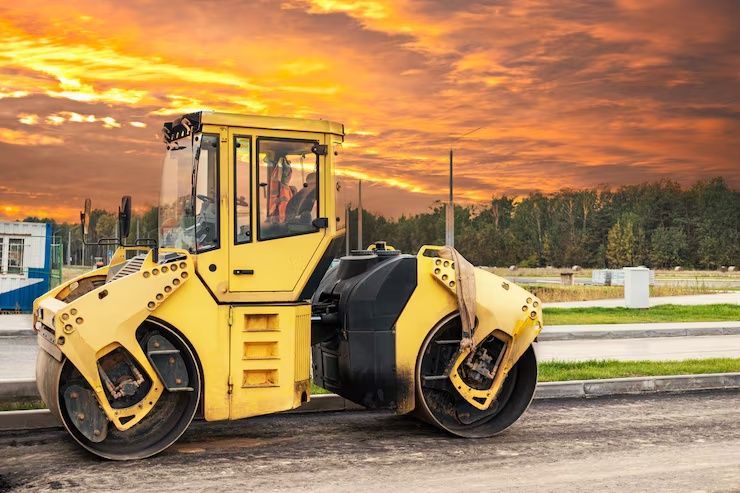Road Roller Machinery plays an important role in construction and infrastructure development. These heavy machines are primarily used to compact soil, asphalt and other material to create stable surfaces for roads, highways, airports and industrial projects.
Road rolls exist because proper compression improves durability, strength and life of roads and foundations. Without effective compression, surfaces can determine unevenly, leading to cracks, giant pots or structural faults.

Importance
Road roller equipment is important for civil engineering and creation for numerous reasons:
Structural Stability: Compacted surfaces can resist heavy traffic and environmental strain.
Efficiency: Speeds up creation methods via making sure uniform density.
Safety: Properly compacted roads lessen the threat of accidents resulting from choppy or weak surfaces.
Cost Savings: Reduces renovation frequency and maintenance through the years.
Versatility: Used in street construction, business tasks, embankments, and landscaping.
Effective use of road rollers guarantees fantastic infrastructure and long-time period venture reliability.
Types of rollers
Road rolls come in different types depending on construction requirements:
Simple drum rolls: Has a large drum front and a tire behind. Ideal for soil and asphalt compression.
Double drum rolls: Equipped with two smooth drums, often used for asphalt roads to achieve a flat surface.
Pneumatic tire rolls: Use multiple rubber tires for uniform pressure distribution; Suitable for asphalt and granular layers.
Vibration rolls: Include vibrations to increase compression efficiency, especially for grainy soils.
Combination rolls: Integrates both drums and pneumatic tires to combine the benefits with both systems.
Each type serves a specific purpose depending on material, website conditions and project requirements.
How Road Rollers Work
Road rollers characteristic through making use of static weight and/or vibration to compress and compact materials.
Static Compaction: The gadget’s weight compresses the soil or asphalt.
Vibratory Compaction: Vibrations reduce air wallet and improve density.
Pneumatic Pressure: Rubber tires distribute uniform strain across the surface for smoother completing.
The aggregate of weight, vibration, and rolling movement guarantees the surface achieves the required power and balance.
Applications of road rollers
Road rolls are used in a wide range of projects:
Road construction and maintenance
Highway and Expressway projects
Airport lanes and taxiBanes
Industrial Facility Construction
Landscaping and Voll projects
Asphalt coating and asphalt layer compacting
By choosing the right roller type, engineers ensure optimal performance for specific applications.
Recent Updates
Between 2024 and 2025, avenue curler machinery has seen several technological improvements:
Emissions reduction: motors now meet strict environmental standards for low CO2 and particle emissions.
Hybrid and electric models: Some manufacturers introduce battery powered and hybrid roads for sustainable construction.
Automation and GPS integration: Modern rolls come with GPS systems for accurate compression mapping and better work flight control.
Vibration control technology: New rolls allow adjustable vibration settings for more efficient compression depending on the type of material.
Improvement of the operator's safety: Improved cottage with ergonomic checks, air conditioning and vibration reduction functions.
These trends reflect a growing feature of environmentally friendly, safer and more accurate compression equipment.
Laws and suggestions
Building machines, along with street rolls, are regulated to make sure protection, environmental compliance and running requirements:
Safety rules within the administrative center: Operators need to observe safety standards and use shielding equipment.
Environmental instructions: Requirements for emissions limit environmental pollutants from diesel engines.
Operating certification: Some international locations require operators to have a license or certification for heavy gadget.
Noise control: Limits for sound emissions to reduce the environmental and family impact.
Following those felony guidelines guarantees secure, responsible and sustainable operations at production websites.
Tools and Resources
Road curler machinery requires right gear and assets for operation, maintenance, and monitoring:
Maintenance Tools: Wrenches, hydraulic fluid kits, greasing tools, and vibration dimension gadgets.
Monitoring Systems: GPS mapping, compaction meters, and digital dashboards for overall performance monitoring.
Operator Training Resources: Manuals, video tutorials, and on-web page education applications for secure and green use.
Replacement Parts: Drum, tires, hydraulic additives, and engine components for regular preservation.
Construction Management Tools: Project tracking equipment to coordinate compaction schedules, equipment allocation, and productivity tracking.
Future tendencies
Environmentally pleasant machines: Hybrid and electric powered rolls will maintain to make bigger.
Automation and AI integration: Fully self reliant rolls for high precision compression.
Digital overall performance tracking: Use of IoT sensors to screen real -time compression quality.
Advanced protection measures: Smart Alert, proximity sensor and automated braking gadget for secure operation.
Global Standardization: Unified Quality and Performance Standards for International Construction Projects.
These developments recommend that street rollers might be greater green, environmentally friendly and technologically superior.
FAQs
Q1. What is the main cause of a avenue roller?
A: Road rollers compact soil, asphalt, and different materials to create stable, long lasting surfaces for roads and infrastructure.
Q2. How do vibratory rollers range from smooth drum rollers?
A: Vibratory rollers use vibration to boom compaction performance, especially in granular soils, even as easy drum rollers rely especially on static weight.
Q3. Can road rollers be used on all styles of soil?
A: Different styles of rollers are perfect to precise soils—unmarried drum for cohesive soils, pneumatic or vibratory rollers for granular or asphalt layers.
Q4. What are the safety considerations for working avenue rollers?
A: Operators must use protective system, comply with operational tips, and maintain safe speeds at the same time as making sure ordinary maintenance.
Q5. Are hybrid and electric street rollers effective?
A: Yes, they provide comparable compaction overall performance whilst reducing emissions, gas consumption, and environmental effect.
conclusion
Road roles are indispensable in modern construction, providing effective compression, improved durability and increased security for infrastructure projects. With progress in technology, emission controls, automation and the operator's safety, these machines develop to meet the requirements for sustainable and precision production.
Understanding the types, applications, equipment and trends for road rollers helps engineers, operators and project managers achieve better results, ensure long life for construction projects and use modern practice in infrastructure development.